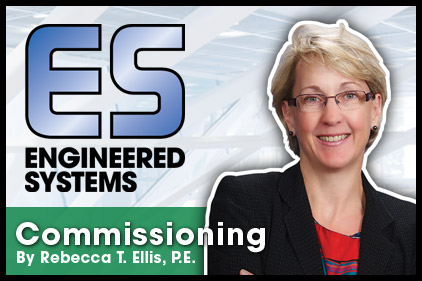In the standard commissioning process, there are two primary technical activities that occur on site at the end of construction and prior to systems acceptance by the owner. The first is completion of Pre-Functional Checklists (PFC), and the second is execution of the Functional Performance Tests (FPT).
In almost all cases, the PFCs are developed by the commissioning professional for completion in the field by the contractors responsible for each system. The commissioning professional collects and reviews the PFCs as a prerequisite for performing the FPTs. The expectation is that 100% of all commissioned systems are subject to the PFC process. This includes each HVAC terminal unit, lighting control zone, and plumbing mixing valve, as well as the central mechanical and electrical systems.
If money and time were no object, functional performance testing of 100% of all systems would also be conducted for the most thorough commissioning process available. However, the time and cost inherent to testing hundreds of VAV terminal units, heat pumps, fan-coil units, lighting occupancy sensors, etc., in a single project typically compels the building owner to accept a random sampling process.
I recommend 100% testing of all central/infrastructure systems and their associated controls. These include central chiller plants, central boiler plants, central air handling systems, and both main and emergency power systems. One hundred percent testing should also extend to mission critical systems, which vary from project to project depending on the building owner’s criteria.
Sampling starts to make economic sense when there are more than 10 of a similar type of non-mission critical system. These are typically industry standard HVAC system terminal units (VAV boxes, unit heaters, perimeter radiation, etc.) and terminal lighting control devices such as occupancy sensors. For projects pursuing LEED certification, my experience is that project reviewers have no problem with sampling rates as low as 20% for these types of systems. I have a personal rule of no less than two tests of each type of similar system.
Control system programming is often copy/paste for these types of systems, and as such, sampling will quickly identify systemic control issues that are likely repeated at all typical systems. The risk of sampling versus 100% testing is the possibility of missing unique hardware failures that have nothing to do with control programming, e.g., disconnected damper actuators, stuck control valves, missing or miswired sensors, and so forth. There is also the possibility that the copy/paste programming technique may result in mismapped control points at some, but not all, of the terminal units.
By choosing to sample versus testing 100% of selected systems, the building owner is making a conscious financial decision to address some of the latter failure scenarios under the normal warranty process once they are found and diagnosed by occupants and facilities management professionals. When deciding which systems to sample, owners need to assess their in-house capacity and skill set to deal with issues in a timely fashion during the warranty period.
Owners also need to evaluate the risk associated with certain systems not functioning properly at the time of project acceptance. For example, there may be some systems, such as hospital surgery suite terminal units, that must be 100% tested while other similar terminal units serving office and support spaces can be sampled. Another example would be a conference center’s meeting room lighting controls needing 100% testing while the same conference center’s back-of-house lighting controls can be sampled.
In summary, FPT sampling is a legitimate commissioning strategy that can be successful if applied thoughtfully and customized for each project.




